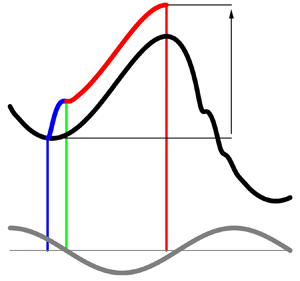Published online by Cambridge University Press: 06 September 2021

Pulsatile channel and pipe flows constitute a fundamental flow configuration with significant bearing on many applications in the engineering and medical sciences. Rotating machinery, hydraulic pumps or cardiovascular systems are dominated by time-periodic flows, and their stability characteristics play an important role in their efficient and proper operation. While previous work has mainly concentrated on the modal, harmonic response to an oscillatory or pulsatile base flow, this study employs a direct–adjoint optimisation technique to assess short-term instabilities, identify transient energy-amplification mechanisms and determine their prevalence within a wide parameter space. At low pulsation amplitudes, the transient dynamics is found to be similar to that resulting from the equivalent steady parabolic flow profile, and the oscillating flow component appears to have only a weak effect. After a critical pulsation amplitude is surpassed, linear transient growth is shown to increase exponentially with the pulsation amplitude and to occur mainly during the slow part of the pulsation cycle. In this latter regime, a detailed analysis of the energy transfer mechanisms demonstrates that the huge linear transient growth factors are the result of an optimal combination of Orr mechanism and intracyclic normal-mode growth during half a pulsation cycle. Two-dimensional sinuous perturbations are favoured in channel flow, while pipe flow is dominated by helical perturbations. An extensive parameter study is presented that tracks these flow features across variations in the pulsation amplitude, Reynolds and Womersley numbers, perturbation wavenumbers and imposed time horizon.